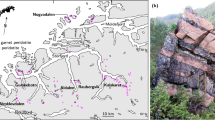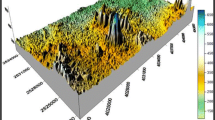Abstract
The major rock-forming mineral phases (pyroxenes, plagioclase, garnet, hornblende) of a suite of granulite-facies gneisses from the Scourian complex, NW Scotland, have been analyzed for their rare earth element (REE) content. Although host rock compositions range from felsic to ultramafic, REE abundances and patterns for each mineral group show only limited variation. The REEs exhibit regular and consistent distribution patterns for each mineral which suggest, together with major element and textural considerations, that the observed distribution coefficients approach equilibrium. Total REE content follows the sequence hornblende>clinopyroxene>garnet>plagioclase >orthopyroxene and mass balance calculations show that even in the felsic gneisses>60% of the REEs reside in the major rock-forming minerals. Comparisons of both relative REE abundances and distribution coefficients with those in other rock types reveal a striking resemblance with patterns observed in mineral-liquid pairs of dacitic rocks. These similarities may have arisen during a partial melting episode in which granite-granodiorite melts were generated and removed from the Scourian complex; leaving a residuum which is severely depleted in the incompatible elements, including the REEs.
Similar content being viewed by others
References
Buma G, Frey FA, Wones DR (1971) New England granites: trace element evidence regarding their origin and differentiation. Contrib Mineral Petrol 31:300–320
Condie KC, Lo HH (1971) Trace element geochemistry of the Louis Lake batholith of early Precambrian age, Wyoming. Geochim Cosmochim Acta 35:1099–1119
Cullers RL. Medaris LG, Haskin L (1973) Experimental studies of the distribution of rare earths as trace elements among silicate minerals and liquids and water. Geochim Cosmochim Acta 37:1499–1512
Deer WA, Howie RA, Zussman J (1971) Rock-forming minerals. London, Longman Group
Drake MJ (1975) The oxidation state of europium as an indicator of oxygen fugacity. Geochim Cosmochim Acta 39:55–64
Drake MJ, Weill DF (1975) Partition of Sr, Ba, Ca, Y, Eu2+, Eu3+ and the other REE between plagioclase feldspar and magmatic liquid: An experimental study. Geochim Cosmochim Acta 39:689–712
Evans CR, Lambert RStJ (1974) The geology of the Lochinver district, Sutherland, the type area of the Inverian metamorphism. J Geol Soc London 130:125–150
Flanagan FJ (1973) 1972 values for international geochemical reference samples. Geochim Cosmochim Acta 37:1189–1200
Frey FA (1970) Rare earth abundances in alpine ultramafic rocks. Phys Earth Planet Interiors 3:323–330
Frey FA, Green DH (1974) The mineralogy, geochemistry and origin of lherzolite inclusions in Victorian basanites. Geochim Cosmochim Acta 38:1023–1059
Frey FA, Haskin LA, Haskin MA (1971) Rare-earth abundances in some ultramafic rocks. J Geophys Res 76:2057–2070
Fyfe WS (1973) The granulite facies, partial melting and the Archean crust. Philos Trans R Soc London A 273:457–461
Gibson IL, Jagam P (1980) Instrumental neutron activation analysis of rocks and minerals. In: GK Muecke (ed) Short course in neutron activation analysis in the geosciences. Mineral Assoc Can Short Course Handbook 5:109–131
Gordon GE, Randle K, Goles G, Corliss J, Beeson M, Oxley S (1968) Instrumental activation analysis of standard rocks with high resolution gamma ray detectors. Geochim Cosmochim Acta 32:369–396
Green DH, Ringwood AE (1967) An experimental investigation of the gabbro to eclogite transformation and its petrological applications. Geochim Cosmochim Acta 31:767–833
Haskin LA, Haskin MA, Frey FA, Wildeman TR (1968) Relative and absolute terrestrial abundances of the rare earths. In: LH Ahrens (ed) Origin and distribution of the elements 1. Pergamon, New York, pp 889–912
Holland JG, Lambert RStJ (1975) The chemistry and origin of the Lewisian gneisses of the Scottish mainland: The Scourie and Inver assemblages and subcrustal accretion. Precambrian Res 2:161–188
Irving AJ, Frey FA (1976) Effects of composition on the partitioning of rare earth elements, Hf, Sc and Co between garnet and liquid; experimental and natural evidence. EOS 57:339
Matsui Y, Onuma N, Nagasawa H, Higuchi H, Banno S (1977) Crystal structure control in trace element partition between crystal and magma. Bull Soc Fr Mineral Cristallogr 100:315–324
Moorbath S, Park RG (1972) The Lewisian chronology of the southern region of the Scottish mainland. Scott J Geol 8:51–74
Moorbath S, Welke H, Gale NW (1969) The significance of lead isotope studies in ancient, high-grade metamorphic basement complexes, as exemplified by the Lewisian rocks of northwest Scotland. Earth Planet Sci Lett 6:245–256
Muecke GK (1969) Petrogenesis of granulite-facies rocks from the Lewisian of North-West Scotland. Ph D Thesis, Oxford University
Muecke GK, Clarke DB (1981) Geochemical evolution of the South Mountain Batholith, Nova Scotia: rare earth element evidence. Can Mineral 45
Muecke GK, Pride C, Sarkar P (1979) Rare earth element geochemistry of regional metamorphic rocks. In: LH Ahrens (ed) Origin and distribution of the elements 2. Pergamon, London pp 449–464
Mysen BO (1976) Rare earth partioning between crystals and liquid in the upper mantle. Carnegie Inst Washington Yearb 75:656–659
Nagasawa H, Schnetzler CC (1971) Partitioning of rare earth, alkali and alkaline earth elements between phenocrysts and acidic igneous magma. Geochim Cosmochim Acta 35:953–968
Onuma N, Higuchi H, Wakita H, Nagasawa H (1968) Trace element partition between two pyroxenes and the host volcanic rocks. Earth Planet Sci Lett 5:47–51
Philpotts JA, Schnetzler CC, Thomas HH (1972) Petrogenetic implications of some new geochemical data on eclogitic and ultrabasic inclusions. Geochim Cosmochim Acta 36:1131–1166
Pride C (1978) Rare earth element studies of a granulite facies terrain: The Lewisian of N.W. Scotland. PhD thesis, Dalhousie University
Pride C, Muecke GK (1980) Rare earth element geochemistry of the Scourian Complex NW Scotland — Evidence for the granite-granulite link. Contrib Mineral Petrol 73:403–412
Rollinson HR, Windley BF (1980) Selective elemental depletion during metamorphism of Archean granulites, Scourie, NW, Scotland. Contrib Mineral Petrol 72:257–263
Schnetzler CC, Philpotts JA (1968) Partition coeffecients of rare-earth elements and barium between igneous matrix material and rock-forming mineral phenocrysts — I. In: LH Ahrens (ed) Origin and distribution of the elements 1. Pergamon, New York, pp 929–938
Schnetzler CC, Philpotts JA (1970) Partition coefficients of rare-earth elements between igneous matrix and rock-forming mineral phenocrysts — II. Geochim Cosmochim Acta 34:331–340
Sheraton JW, Skinner AC, Tarney J (1973) The geochemistry of the Scourian gneisses of the Assynt district. In: RG Park, J Tarney (eds) The early Precambrian of Scotland and related rocks of Greenland. Univ of Birmingham Press pp 13–20
Sutton J, Watson J (1951) The pre-Torridonian metamorphic history of the Loch Torridon and Scourie areas in the North-West Highlands and its bearing on the chronological classification of the Lewisian. Q J Geol Soc London 106:241–296
Varne R, Graham AL (1971) Rare earth abundances in hornblende and clinopyroxene of a hornblende Iherzolite xenolith. Implications for upper mantle fractionation processes. Earth Planet Sci Lett 13:11–18
Vernon RH (1975) Metamorphic processes: reactions and microstructure development. Wiley, New York, 274 pp
Wood BJ (1976) Samarium distribution between garnet and liquid at high pressure. Carnegie Inst Washington Yearb 75:659–662
Author information
Authors and Affiliations
Rights and permissions
About this article
Cite this article
Pride, C., Muecke, G.K. Rare earth element distributions among coexisting granulite facies minerals, Scourian complex, NW Scotland. Contr. Mineral. and Petrol. 76, 463–471 (1981). https://doi.org/10.1007/BF00371488
Accepted:
Issue Date:
DOI: https://doi.org/10.1007/BF00371488




